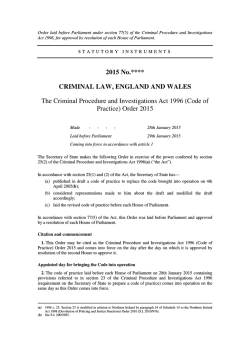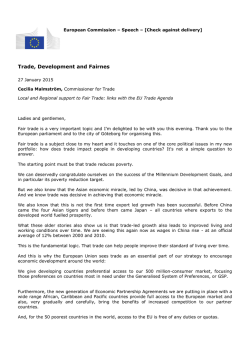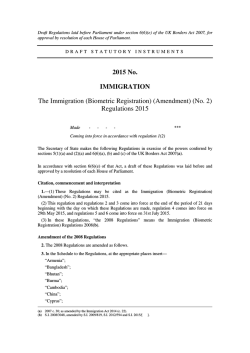
Dissolution of Parliament
Dissolution of Parliament Standard Note: SN/PC/05085 Last updated: 28 January 2015 Author: Richard Kelly Section Parliament and Constitution Centre Parliament is dissolved automatically under provisions in the Fixed-term Parliaments Act 2011. Prior to the Act, dissolution was a personal prerogative of the Queen. The Act has replaced the prerogative and now Parliament is dissolved automatically 25 working days before a general election. The Act provides that parliamentary general elections take place every five years on the first Thursday in May. It also provides for early general elections if either the House of Commons votes for an early general election or following the failure of the House to agree a vote of confidence in a new government within 14 days of a vote of no confidence in the government holding office. The Fixed-term Parliaments Act 2011 sets the date of the next general election as 7 May 2015, accordingly this Parliament will dissolve on 30 March 2015. This Note also sets out the previous procedure for the dissolution of Parliament and notes that reforms to the previous procedure were proposed in the green paper The Governance of Britain in July 2007. This information is provided to Members of Parliament in support of their parliamentary duties and is not intended to address the specific circumstances of any particular individual. It should not be relied upon as being up to date; the law or policies may have changed since it was last updated; and it should not be relied upon as legal or professional advice or as a substitute for it. A suitably qualified professional should be consulted if specific advice or information is required. This information is provided subject to our general terms and conditions which are available online or may be provided on request in hard copy. Authors are available to discuss the content of this briefing with Members and their staff, but not with the general public. Contents 1 The dissolution of Parliament under the Fixed-term Parliaments Act 2011 2 1.1 2 Timing of elections 2 The previous dissolution procedure 3 3 The meeting of Parliament 4 3.1 5 The timing of the meeting of the 2010 Parliament 4 Practical dissolution guidance 6 5 Governance of Britain green paper proposals on dissolution 6 1 The dissolution of Parliament under the Fixed-term Parliaments Act 2011 Under section 3 of the Fixed-term Parliaments Act 2011, Parliament is dissolved automatically 25 working days before a general election. The Act had originally provided for a 17 working day election timetable, not including the day of dissolution, but this has been amended by Section 14 of the Electoral Registration and Administration Act 2013 which extended the length of the parliamentary election timetable to 25 days.1 The Fixed-term Parliaments Act 2011 sets the date of the next general election as 7 May 2015, accordingly this Parliament will dissolve on 30 March 2015. The Fixed-term Parliaments Act 2011 states that “Parliament cannot otherwise be dissolved”.2 In Constitutional & Administrative Law (7th edition), Neil Parpworth noted that “as a consequence of the Fixed-term Parliaments Act 2011, the power to dissolve Parliament no longer vests with the monarch”.3 The responsibility for issuing the writs for the election becomes a statutory responsibility of the Lord Chancellor and the Secretary of State for Northern Ireland, although there is expected to be a continuing role for the Crown Office to despatch the writs.4 The Fixed-term Parliaments Act 2011 provides that “Once Parliament dissolves, Her Majesty may issue the proclamation summoning the new Parliament”.5 1.1 Timing of elections Section 1 of the Fixed-term Parliaments Act 2011 sets the date of the next UK general election as Thursday 7 May 2015. Thereafter, the first Thursday in May in the fifth calendar year is set as the next polling day. There is scope for the Prime Minister to lay an order before both Houses to extend this date for a maximum of two months to deal with unexpected developments. He/she must set out the reasons for the delay. Section 2 provides for early general elections when either of the following conditions is met: 1 2 3 4 5 See Library Standard Note 6574, Timetable for the UK Parliamentary general election for further details Fixed-term Parliaments Act 2011 (chapter 14), section 3(2) Neil Parpworth, Constitutional & Administrative Law, 7th edition, 2012, para 4.23 Section 3(3). At present, the Lord Chancellor undertakes this function once there has been an Order in Council. Fixed-term Parliaments Act 2011 (chapter 14), section 3(4) 2 if a motion for an early general election is agreed either by at least two-thirds of the whole House (including vacant seats) or without division; or if a motion of no confidence is passed and no alternative government is confirmed by the Commons within 14 days by means of a confidence motion. The Act provides for a set formula to be used in determining a question of no confidence. Firstly, the motion would be: “That this House has no confidence in Her Majesty’s Government”. If this motion is carried, there is a 14 calendar day period in which to form a new Government, confirmed in office by a resolution as follows: “That this House has confidence in Her Majesty’s Government” If a new Government cannot be formed within this time period, then dissolution is triggered. There is no provision for an extension of the 14 day period. Dissolution need not follow immediately on a triggering event, as section 2(7) allows for the Prime Minister to recommend a suitable polling day to the Crown. When the day of the election is confirmed, the date of dissolution can be determined. A proclamation for a new Parliament can then be issued. 2 The previous dissolution procedure Until the passage of the Fixed-term Parliaments Act 2011, the United Kingdom did not have set timings for general elections or fixed-term Parliaments. The Septennial Act 1715, as amended by section 7 of the Parliament Act 1911, merely required that a Parliament be dissolved after a maximum of five years. In theory, once five years had passed, a Parliament expired, but in practice the Prime Minister normally requested a dissolution from the Monarch before that date. The five years ran from the first meeting of Parliament following the general election. The timetable for the next general election was then set in motion, unless dissolution had been requested earlier. The current Parliament was summoned to meet on Tuesday 18 May 2010, so would have been expected to cease to exist at midnight on Sunday 17 May 2015.6 Dissolution of Parliament was a prerogative act and could occur at any time; Parliament did not need to be sitting, or to be recalled, for the purpose of dissolution. In 1992, 1997, 2005 and 2010 dissolution was preceded by prorogation of Parliament. However in 2001, Parliament was dissolved without being prorogued beforehand. Instead Parliament was adjourned on 11 May 2001. The proclamation declaring the dissolution also established the day for the meeting of a new Parliament and, under the Representation of the People Act 1983, thereby set the timetable for the coming general election. Although generally speaking the timing of a general election was in the gift of the Prime Minister, a dissolution and general election could have been precipitated if the Government lost a vote of confidence in the House of Commons and could no longer command a majority. The most recent example was on 28 March 1979 when an Opposition motion of no confidence in the Callaghan Government was carried with a majority of one; the result led to 6 Further information on the general election timetable before the Fixed-term Parliaments Act 2011 is available in Library Research Paper 09/44 Election Timetables 3 the dissolution of Parliament and the victory of the Conservative Party in the following general election. Erskine May describes the parliamentary treatment of censure motions: From time to time the Opposition put down a motion on the paper expressing lack of confidence in the Government or otherwise criticising its general conduct. By established convention the Government always accedes to the demand from the Leader of the Opposition to allot a day for the discussion of a motion tabled by the official Opposition which, in the Government’s view, would have the effect of testing the confidence of the House. In allotting a day for this purpose the Government is entitled to have regard to the exigencies of its own business, but a reasonably early day is invariably found. This convention is founded on the recognised position of the Opposition as a potential Government, which guarantees the legitimacy of such an interruption of the normal course of business. For its part, the Government has everything to gain by meeting such a direct challenge to its authority at the earliest possible moment.7 3 The meeting of Parliament The date of a forthcoming election was normally announced by the Prime Minister some days before prorogation or adjournment and subsequent dissolution, thus allowing a few days to finish Parliamentary business. The announcement that a general election is to take place has, since 1945, normally been made to the press rather than to Parliament. Earlier in the century it was customary to make the statement to the Commons (when not in recess).8 The dates on which recent Prime Ministers announced the four most recent general elections are set out in Box 1. Box 1: Dates on which general elections were announced, 1997-2010 On 6 April 2010 Gordon Brown announced the date of the general election outside no 10, following the practice of Tony Blair in announcing the 2005 election on Tuesday 5 April outside 10 Downing Street. Parliament was prorogued on Thursday 8 April 2010. In 2001, Tony Blair had announced the election date of 7 June on 8 May, at St Saviour's & St Olave's Church of England School in Bermondsey, south London. Parliament was subsequently dissolved on 11 May 2001. In 1997, John Major announced the election date of 1 May on March 17 1997 to the press outside 10 Downing Street. As noted above, the proclamation declaring the dissolution also established the day for the meeting of a new Parliament. It is possible to postpone the date for the meeting of Parliament. In The Meeting of Parliament, Professor Robert Blackburn commented: On the third interval, from the poll to the meeting of the new Parliament, there is no statutory maximum to ensure that Parliament actually meets. Furthermore, the date fixed for the meeting in the Proclamation may be postponed by the act of a further 7 8 Erskine May, Parliamentary Practice, 24th edition, 2011, p344 For more information see Robert Blackburn’s The Meeting of Parliament, 1990 4 Royal Proclamation in the interim, declaring a prorogation of any period, “to the day and place in such Proclamation appointed, notwithstanding any former law, usage, or practice to the contrary”, so long as it is not less than 14 days from the date of the postponing Proclamation.9 The relevant legislation is the Prorogation Act 1867: 1 Power to Her Majesty to issue proclamation for the prorogation of Parliament Whenever (save as herein-after excepted) Her Majesty shall be pleased, by and with the advice of the Privy Council of Her Majesty, to issue her royal proclamation to prorogue Parliament from the day to which it shall then stand summoned or prorogued to any further day being not less than fourteen days from the date thereof, such proclamation shall, without any subsequent issue of a writ or writs patent or commission under the Great Seal of the United Kingdom, be a full and sufficient notice to all persons whatever of such the royal intention of Her Majesty, and the Parliament shall thereby stand prorogued to the day and place in such proclamation appointed, notwithstanding any former law, usage, or practice to the contrary. 2 Not to apply to prorogation at close of a session This Act shall not apply to the case of the prorogation of Parliament at the close of a session.10 The 24th edition of Erskine May explains the effect of the Prorogation Act 1867.11 In a footnote May refers to the Parliament summoned to meet on 18 November 1924 being prorogued from 18 November until 2 December 1924.12 It is worth noting that the 1867 Act appears to preclude a subsequent proclamation bringing forward the date of the meeting of Parliament. 3.1 The timing of the meeting of the 2010 Parliament In June 2007 the Modernisation Committee report Revitalising the Chamber: The Role of the Backbencher: recommended a longer period between polling day and first meeting of Parliament, noting that a period of over a week had been common between 1955 and 1970: 39. There is no desire to create too long a gap between a general election and the first meeting of Parliament. However, there should be a longer gap than usually occurred in the past between the election and the day the House first meets to permit some of the practicalities that prevent Members from focusing on their new job to be addressed and to make time for an induction programme before the House starts its work. We recommend that the gap should be about twelve days. 13 The Government response to Revitalising the Chamber was published in October 2007. It accepted the principle of this recommendation.14 The proclamation dissolving the 2005 Parliament and summoning the 2010 Parliament did give a later date than usual for the meeting of the new Parliament:- 18 May 2010. A press notice from 10 Downing St noted that: 9 10 11 12 13 14 Robert Blackburn, The Meeting of Parliament, 1990, p8 Prorogation Act 1867 (chapter 81) Erskine May, Parliamentary Practice, 24th edition, 2011, p146 CJ (1924-25) 2 Modernisation Committee, Revitalising the Chamber: The Role of the Backbencher HC 337 2006-07 Office of the Leader of the House of Commons, Revitalising the Chamber – The role of the back bench Member, Cm 7231, October 2007, para 6 5 The date of Parliament’s return reflects the wishes of the Speaker and the new arrangements proposed by the cross-party House of Commons Modernisation Committee in their June 2007 report “Revitalising the Chamber”. The Government accepted this recommendation.15 4 Practical dissolution guidance Guidance on dissolution arrangements for Members – both those standing at the forthcoming general election and those retiring – and their staff is available on the parliamentary intranet.16 The effect of dissolution is outlined in the introduction: During the period when Parliament is dissolved before a General Election there are no Members of Parliament. Consequently you may not use that title during this period. From 5pm on the day of dissolution, the facilities that the House provides for Members in Westminster during a Parliament will not be available to you. Links are provided to separate guidance from IPSA for Members.17 All of IPSA’s Dissolution Guidance is available on IPSA's General Election website. It includes information for MPs standing for re-election, MPs standing down in May, MPs’ staff and prospective parliamentary candidates. 5 Governance of Britain green paper proposals on dissolution On 3 July 2007, less than a week after he became Prime Minister, Gordon Brown, published his proposals for constitutional reform in a Green Paper, The Governance of Britain. Amongst its proposals was one to give a more formal role to Parliament in terms of its dissolution and recall. Further information about other proposals is given in Library Research Paper 07/72 The Governance of Britain Green Paper. The Green Paper proposed that, rather than the dissolution of Parliament occurring only at the request of the Prime Minister, or at the end of a five-year period, that the Prime Minister should have to seek the approval of the House of Commons before asking the Monarch to dissolve Parliament. Any new arrangements would have to provide for the situation in which it proves impossible to form a government which commands the support of the House of Commons yet Parliament refuses to dissolve itself. The Government announced that it would consult on these proposals and any change would be announced to Parliament and would become through precedent, a new convention.18 The Green Paper also announced plans to allow Members more control over the recall of the Commons, currently governed by Standing Order 13.19 On 11 October 2007 the Modernisation Select Committee announced an inquiry into the recall and dissolution of Parliament.20 It received a number of submissions, but did not hold 15 16 17 18 19 20 “General election to take play on 6 May” No 10 Downing St Press Notice Parliamentary intranet, House of Commons dissolution guidance Parliamentary intranet, House of Commons dissolution guidance: see Introduction Ministry of Justice, The Governance of Britain, July 2007, Cm 7170, paras 34-36 For more information, see: House of Commons Library Standard Note SN/PC/1186, Recall of Parliament Modernisation Committee Press Notice, 11 October 2007; full terms of reference were published in a Press Notice on 24 October 2007 6 evidence sessions or issue a report. The submission from the Leader to the House, Harriet Harman, explained in more detail the proposed change.21 The passage of the Fixed-term Parliaments Act 2011 means that normally the House of Commons would have no role to play in the dissolution of Parliament. However, an early general election could only follow a decision of the House of Commons. 21 Modernisation Committee Memorandum from the Leader of the House of Commons (M58) 2007-08 February 2008 7
© Copyright 2025





